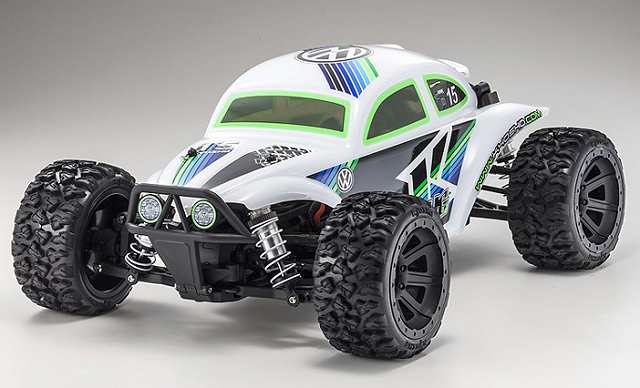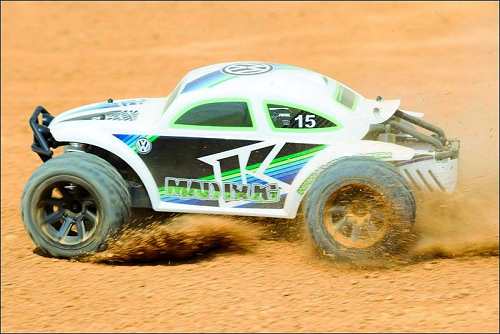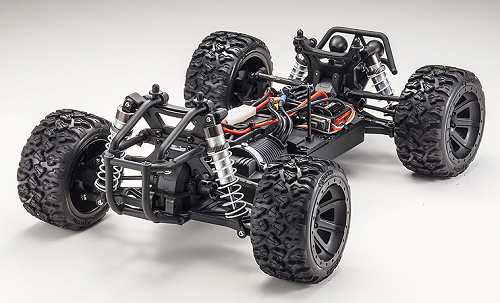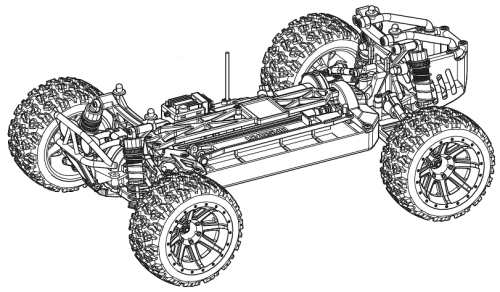

|


|
|
1/10 Scale Electric Truck/Truggy:
Kyosho Mad Bug VE - 30994
|
Released by Kyosho in 2014, the 4WD EP Mad Bug VE ReadySet Truck - # 30994 - comes with a NEO ONE series KV-2400 Brushless motor, Syncro KT-200 Radio System and R10 ONE ESC.
Two versions were available: T1 - with a White bodyshell, and T2 - with a Navy Blue bodyshell.
The Kyosho model is shaft driven, on a molded plastic chassis, with gear differentials, coil spring over oil filled dampers, dogbone drive-shafts and a full set of ball bearings.
Check out our Kyosho Archive for other Vintage Truck models.

To race the Kyosho Mad Bug VE, it requires a high level of tuning for improved stability when cornering, to keep it on the track and give you more grip under acceleration. Even the smallest change in your cars settings can make a Big difference. Our simple to follow instruction chart will show how to attain the best Set-up for your personal requirements.








|
|
|

★ Kyosho Mad Bug VE ★

★ Kyosho Mad Bug VE Chassis ★

★ Kyosho Mad Bug VE Chassis ★

|
Buying a Used Kyosho Mad Bug VE
|
|
Manufacturers and Brands Catalogued, Listed and Reviewed by RC-Scrapyard.
At present, the RC Model Manufacturers, Brands and Distributors covered by us are: ABC Hobby, Academy, Acme Racing, Agama Racing, Amewi, Ansmann Racing, ARRMA, Team Associated, Atomic RC, Axial, AYK, Bolink, BSD Racing, Capricorn, Carisma, Carson, Caster Racing, Cen, Corally, Custom Works, Durango, Duratrax, ECX - Electrix, Exceed RC, FG Modellsport, FS-Racing, FTX, Fujimi, Gmade, GS-Racing, Harm, HBX, Helion, Heng Long, Himoto Racing, Hirobo, Hitari, Hobao, Hong-Nor, Hot Bodies, HPI, HSP, Intech, Integy, Jamara, JQ Products, Kawada, Kyosho, Losi, LRP, Maisto, Mardave, Marui, Maverick, MCD Racing, Megatech, Mugen, New Bright, Nichimo, Nikko, Nkok, Ofna, Pro-Pulse, Protech, PTI, RC4WD, Redcat Racing, RJ-Speed, Robitronic, Schumacher, Seben, Serpent, Smartech, Sportwerks, Step-Up, Tamiya, Team-C Racing, Team Magic, Thunder Tiger, Tomy, Top Racing, Traxxas, Trinity, Tyco, Vaterra RC, Venom, VRX Racing, WLToys, X-Factory, Xmods, Xpress, Xray, XTM, Yankee RC, Yokomo, ZD Racing and Zipzaps. |
|
Hints, Tips and Information Electric Motors for RC ModelsBrushless Motor Basics
Choosing the right Brushless motor for your needs can be a daunting task for those new to Radio Controlled Models. If you have a local club perhaps you could ask some of the more experienced members for their advice, but a little basic knowledge about the subject, so you know what questions to ask is always useful. |
|
Hints, Tips and Information
Wheel Caster Explained
Caster is basically the angle the steering kingpins or steering pivot points, leans back in relation to the horizontal when viewed from the side of the chassis. |
|
RC Models:
|
Radio & Motors: |
Other
Accessories: |